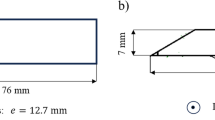Abstract
Cutting tool materials belong to a group of nonductile materials. Chipping and breaking of the cutting edge and fracturing of the tool are common types of tool failure even under conventional machining conditions. This leads to a concern about whether cutting tool materials are able to maintain their strength and toughness and withstand the low-temperature thermal shock during cryogenic machining. The objective of this investigation was to study the behaviors of these kinds of materials at cryogenic temperatures. The results will also serve as a basis in selecting the suitable cutting tool materials for cryogenic machining and in determining the cryogenic strategy and optimum cutting conditions. Several representative cutting tool materials, such as five grades of commercial carbide-cobalt alloys and M46 highspeed steel, are investigated in terms of microstructural observation, impact testing, transverse rupture strength measurement, and indentation testing. It has been shown that carbide tool materials generally retain their strength and toughness as the temperature decreases to liquid nitrogen temperature. The behaviors of carbide tool materials at cryogenic temperatures can be explained in terms of the temperature effects on the binder phase.
Similar content being viewed by others
References
H. Necishi, K. Aoki, and T. Sata,Ann. CIRP, Vol 30,1981, p 43.
J. Takagi and M.C. Shaw,Ann. CIRP, Vol 30,1982, p 53.
A. Uehara and S. Kumagai,Ann. CIRP, Vol 17, 1968, p 409.
K. Uehara and S. Kumagai,Ann. CIRP, Vol 19, 1970, p 273.
“Designing with Kennametal,” Kennametal, Inc., 1980, p 16–17.
G.P. McCleary,Proc. 23rd ASLE Annual Meeting, May 6–9, 1968, Cleveland, p 324.
Annual Book of ASTM Standards, B406–76, ASTM, 1976.
A.T. Santhanam, P. Tierney, and J.L. Hunt, inMetals Handbook, 9th ed., ASM International, 1991, p 950.
M.T. Laugier,Mater. Sci. Eng., Vol A105J106,1988, p 363.
H.C. Lee and J. Gurland,Mater. Sci. Eng., Vol 33, 1978, p 125.
M.S. Koval’chenko, V.V. Dzhemelinskii, V.N. Skuratovskii, Yu.G. Tkachenko, D.Z. Yurchenko, and V.l. Alakseev,Porosh. Metall, Vol 104, 1971, p 87 (translation).
E. Almond, inScience of Hard Materials, R.K. Viswanadham, D.J. Rowcliffe, and J. Gurland, Ed., Plenum, 1983, p 517.
Principles of Tungsten Carbide Engineering, 2nd ed., Society of Carbide and Tool Engineers, 1989, p 7–15.
Source Book on Materials Selection, Vol 1, American Society for Metals, 1977, p 27.
D. Peekuer and M.W. Riley,Materials in Design Engineering, Special Report No. 185, 1986, p 111.
A.D. Krawitz,Mater. Sci. Eng., Vol 75, 1985, p 29.
A.D. Krawitz, M.L. Crapenhoft, D.G. Reichel, and R. Warren,Mater. Sci. Eng., Vol 105J106, 1988, p 275.
P. S. Tumer,J.Res.Natl.Bur. Stand., Vol 37, 1946,p239.
R.W. Bratt,Cutting Tool Materials, American Society for Metals, 1980, p 136.
Author information
Authors and Affiliations
Rights and permissions
About this article
Cite this article
Zhao, Z., Hong, S.Y. Cryogenic properties of some cutting tool materials. JMEP 1, 705–714 (1992). https://doi.org/10.1007/BF02649252
Published:
Issue Date:
DOI: https://doi.org/10.1007/BF02649252




